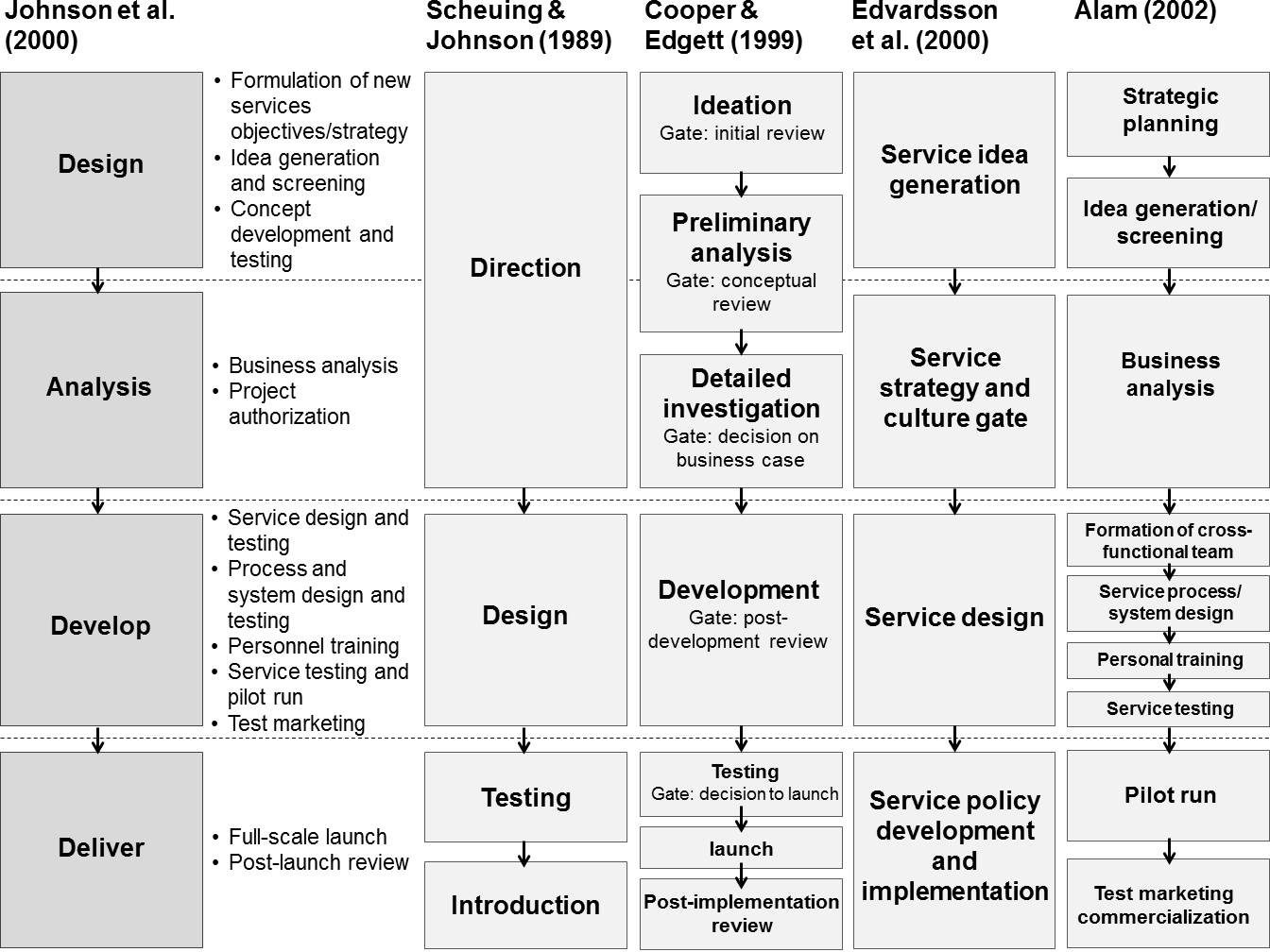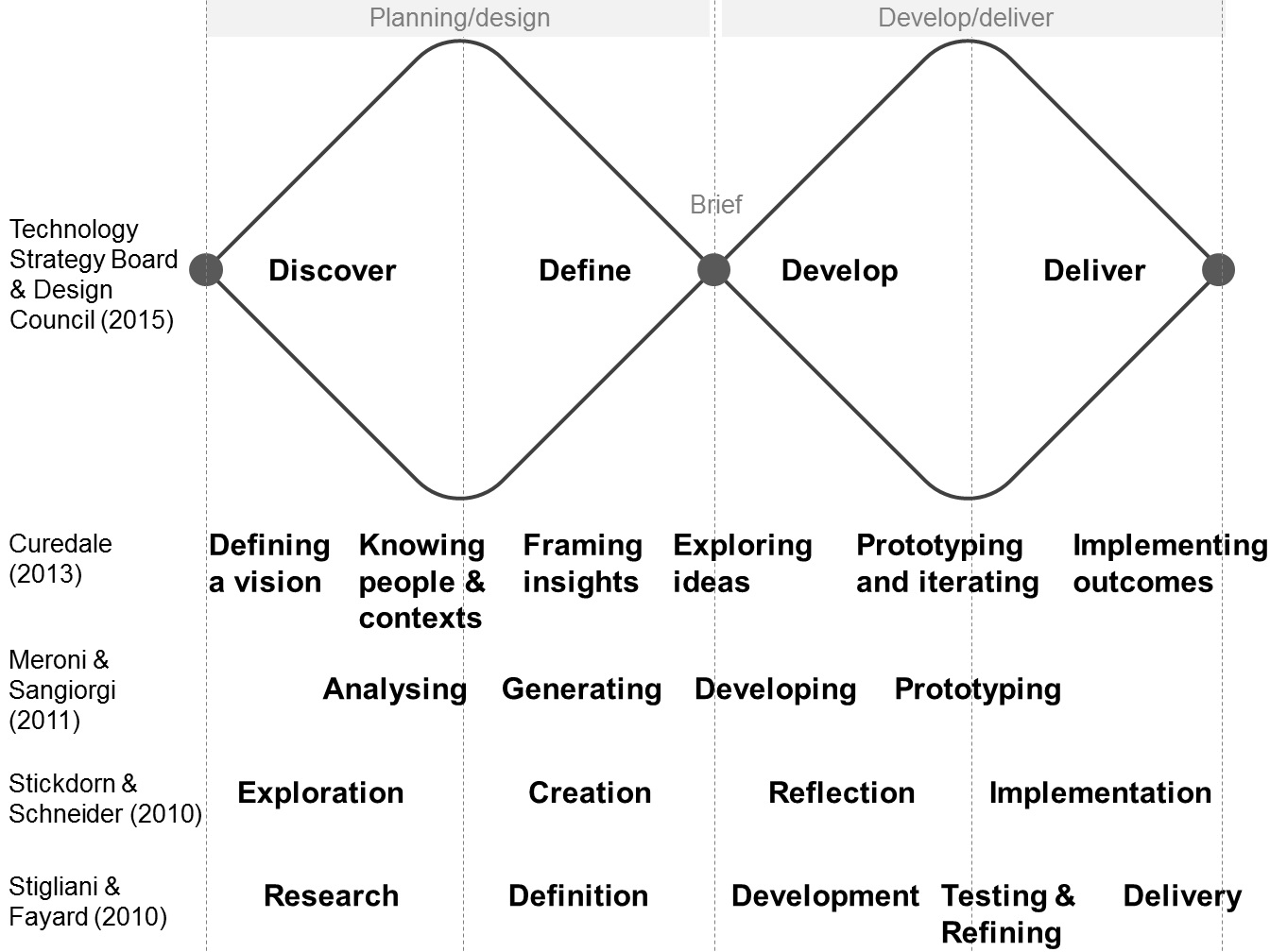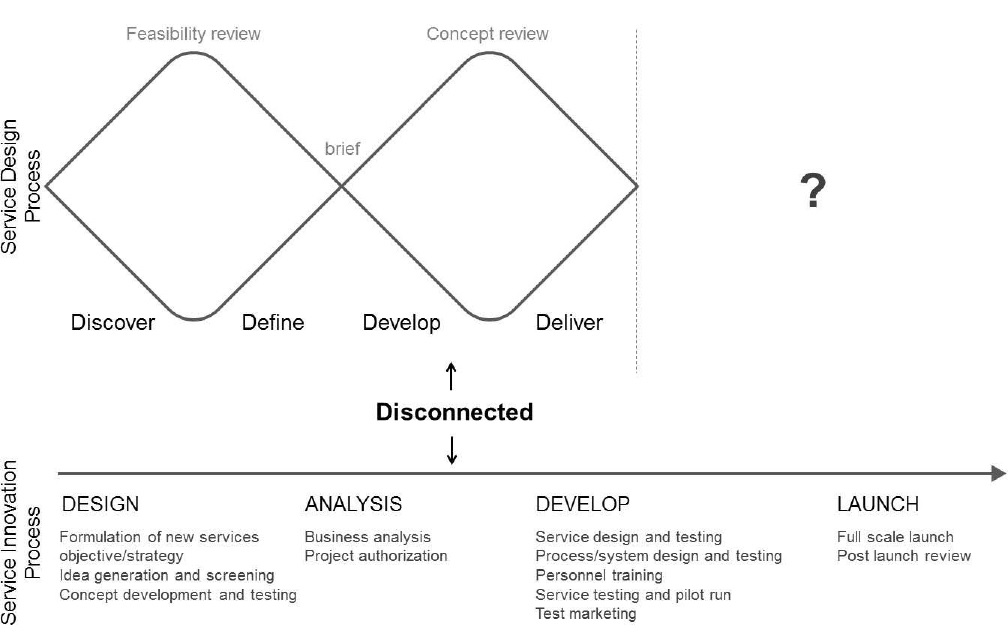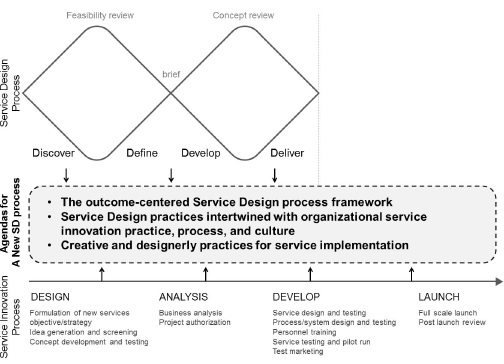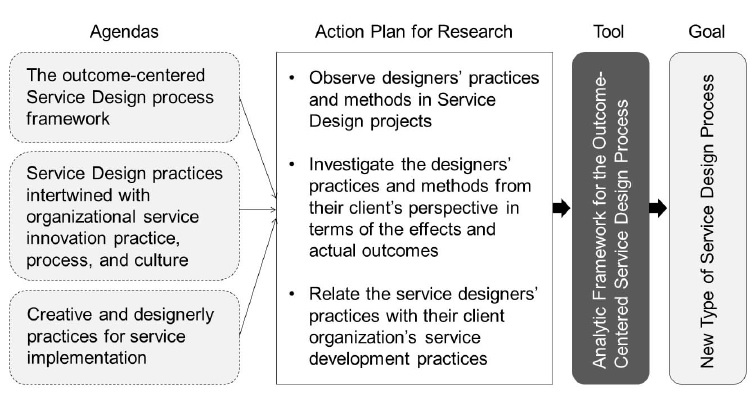
A Reflection on and Suggestion of Service Design Processes: from Activity-Centered Descriptions toward Outcome-Oriented Demonstrations
Background Along with increasing discussions of Service Design (SD), designers’ perspective, approach, activities, and methods for service innovation have been explored as a design-led contribution to service innovation. SD processes have also been developed, strongly informed by general design processes. However, there is a lack of investigations taking a critical view on these SD processes in light of their relation to organizational innovation practices.
Methods A literature study on SD and service innovation processes was conducted to confront SD activities from the design perspective with organizational innovation activities from the business perspective. This enabled the SD processes and activities to be contextualized within the organizational innovation process, suggesting potential limitations of SD processes. Moreover, the opinions of 7 SD experts in UK SD agencies were integrated with the theoretical insight.
Results As a way to guide the development of future SD process frameworks, three agendas, an action plan, and an analytical framework have been suggested. Through the construction of these conceptual tools, this study argues for a shift of an approach to innovating SD processes from the activity-centered description of a design perspective, approach, and activities toward the outcome-oriented demonstration of them in the context of organizations.
Conclusions This study forms a basis for the development of SD processes that better reflect the organizational process and practices. Although SD has been growing as an arena for design research and practice, its activities and approaches can have a significant and transformational value only when they are linked to organizational innovation practice.
Keywords:
Service Design, Service Design Process, Service Innovation Process1. Introduction
Since Service Design (SD) emerged as a domain for design contributions to service innovation along with the establishment of SD agencies such as Livework and Engine in the UK, a wide range of academic debates has been also discussed for the last 20 years (Meroni & Sangiorgi, 2011). Designers’ perspective, approach, role, activities, and methods for service innovation have been explored as a design-led contribution to service innovation (Polaine et al., 2013; Stickdorn & Schneider, 2010). Also, an attempt to build a systematic approach to service development has generated diverse SD process frameworks (Curedale, 2013; Stickdorn & Schneider, 2010). According to these process frameworks, designers provide various kinds of design activities during different stages of service development processes from idea generation to service implementation.
Although these frameworks provide general insight on design activities for innovation, their applicability or validity has not been empirically proven. For example, given recent practical critiques about designers’ lack of capabilities for implementation, which means converting conceptual ideas or concepts into business (Mulgan, 2014), the validity of the descriptions on design activities for service development or implementation remains uncertain or even doubtful. Therefore, a few questions can be raised. Do these SD process frameworks represent real design activities for service innovation in practice? If not, what is missing and what may be the limitation of these frameworks? How this limitation could be overcome in the future SD process frameworks?
The present research aims to take a critical look at existing SD process frameworks by contextualizing them in organizational service innovation process frameworks. Comparing the SD process frameworks built from a design perspective with organizational service innovation processes defined from a business perspective can enable a new understanding of SD processes and activities from the organizational perspective. This understanding is further extended by the discussion of remarks of 7 SD experts. This study concludes with the suggestion of a conceptual framework for the future development of SD processes.
2. Service innovation processes and SD processes
2. 1. Service innovation processes
A systematic and well-organized approach to service innovation has been manifested in marketing/management studies in the form of service innovation processes. As well-structured service innovation processes have been considered as a critical factor for the success of innovation (Griffin, 1997; Scott, 1994), different service innovation processes have been framed by different researchers (Alam, 2002; Cooper & Edgett, 1999; Edvardsson et al., 2000; Scheuing & Johnson, 1989; Valarie A Zeithaml & Bitner, 1996). Being rooted in New Product Development (Booz et al., 1982), these service innovation processes describe a series of stages and associated actions.
These processes generally start with idea generation and screening, proceed to business analysis and service process and resource development, and end with testing and launching the service. Despite variation, diverse stages converge on several distinct phases to design, analysis, develop, and deliver the service. The process of Johnson et al. (2000) well represents how the four distinct phases can embrace different actions and activities, best synthesizing prior service innovation models. (Figure 1).
The ‘design’ stage includes idea and concept development, while the ‘analysis’ stage covers business analysis and project authorization. The ‘develop’ stage is concerned with service process and system development and personnel training, while the ‘deliver’ stage includes service launch and post-launch review.
These service innovation processes represent how service innovation in organizations can be achieved through systematic steps and specific actions. Therefore, reflecting SD processes against these service innovation process frameworks can help to understand how the design activities described in SD processes can engage with the organizational innovation process. As the framework of Johnson et al. (2000) has been considered as widely applicable due to its comprehensiveness and generalizability (Froehle & Roth, 2007), it is adopted in this study as a basis against which SD processes are contextualized and reflected.
2. 2. SD processes
SD literature has defined various SD processes, largely relying on the double-diamond model, which originated from the general design process by the UK Design Council (Technology Strategy Board & Design Council, 2015). The double-diamond framework consists of four D-phases: Discover, Define, Develop, and Deliver. The Discover phase includes exploring inspiration, user needs, and initial ideas, while the Define phase indicates defining design problems and generating a design brief. The Develop phase is about creating and refining solutions and prototyping them, while the Deliver phase covers finalising service solutions and launching them.
Many studies have specified particular design activities constituting service innovation processes (Curedale, 2013; Meroni & Sangiorgi, 2011; Stickdorn & Schneider, 2010; Stigliani & Fayard, 2010). For example, Stickdorn & Schneider (2010) outlined the SD process stages as exploration, creation, reflection, and implementation. According to Stigliani & Fayard (2010), the SD process consists of a research phase by ethnographic methods, a definition phase for idea generation, a development phase based on generating and testing solutions, and a delivery phase for launching services. Similarly, Curedale (2013) described the SD process as a structure built on several key activities including: defining a vision, knowing people and their context, framing insights, exploring ideas, prototyping and iterating, and implementing the outcomes. Meroni & Sangiorgi (2011) instead simplified the SD process as four main activities, which are analysing, generating, developing, and prototyping. These SD processes are comparatively represented in Figure 2.
As seen in this figure, current SD frameworks are well aligned with the double-diamond design process despite some variations of languages and stages. It is argued that SD processes are flexible according to different project contexts and designers keep interative development processes across different stages (Stickdorn & Schneider, 2010). While, these SD processes articulate distinct phases and describe designers’ perspective, approaches, and activities, they are mainly understood from the design perspective. Therefore, how they can be linked to service innovation processes within business is not clear.
3. Contextualizing SD processes in service innovation processes
As discussed earlier, SD processes, despite some variation in terms of labels or stages, represent similar activities that are described to support the whole service innovation process. However, the description of these design activities fails to reflect how they actually interact and engage with organizational service development and innovation practices. As a result, current SD process frameworks cannot demonstrate the role and impact of design activities on real organizational practice. Therefore, as an attempt to close the gap, the four phases in the SD process were confronted with the four phases in service innovation process to compare the two groups of key activities and main actors involved in the distinct stages as described in the literature including Froehle & Roth (2007); Johnson et al. (2000); Stickdorn & Schneider (2010); Technology Strategy Board & Design Council (2015); Valarie A. Zeithaml et al. (2013). This confrontation of the two disciplinary processes helped to understand how the design activities were (or not) aligned to the organizational innovation activities (Table 1).

Contextualizing the SD process in the service innovation process. Source:Johnson et al. (2000); Technology Strategy Board & Design Council (2015). Adapted from Yu (2016, p. 182).
These activities described in the two design and innovation processes are seemingly similar. In particular, the design activities in Discover, Define, and Develop seem to be coupled with organizational activities belonging to the Design and Development stages of the service innovation process. The Analysis and Full Launch stages of the service innovation process do not seem to be much related to designers’ activities. But, this link between the two groups of activities remains very superficial and theoretical, as from a critical view, most of the design activities in the SD process only indicate what designers do, make, or deliver without the actual outcomes that the designer’s actions, methods, or outputs bring to organizational innovation practices.
From the perspective on the actors, while marketing/management literature indicate the need for involving external designers in the Design stage of the New Service Development (NSD) process for mainly user research (Valarie A. Zeithaml et al., 2013), the other three stages: Analysis, Development, and Full Launch are not necessarily described associated with external designers’ practices. The gap between SD processes and service innovation practices is even bigger in the implementation stage. Some SD processes do not proceed beyond the prototyping phase, omitting activities for the delivery phase (Meroni & Sangiorgi, 2011). Other SD processes do include the implementation phase, yet not articulate whether the phase refers to handing over design outputs to clients or implementing the service. For example, in Table 1, the statement of “the resulting product or service is finalised and launched” and “The key activities and objectives during this stage are: final testing, approval and launch, targets, evaluation and feedback loops” do not even clarify specific design activities, nor do make a distinction between designers’ role and clients’ role. That is why it is difficult to clearly define who are the main actors involved in this deliver stage and what their role is exactly about.
Therefore, although existing SD studies outline design activities as spanning the whole service innovation and development process, it can be assumed that the actual position and contextualization of SD processes in the organizational innovation process can be represented as Figure 3.
The Table 1 and Figure 3 indicate two main insights on the current SD processes and activities:
- 1) The lack of links with organizational service innovation processes in the description of SD processes
- 2) Unknown or limited SD contributions to service development and implementation
The first insight relates with the design-activity-centered description of SD practices in most of the SD process in the literature. Unlike products, services are intrinsically activated through organizational resources including human resources, facilities, internal structures, visions/missions, and norms/ cultures (Froehle & Roth, 2007). Therefore, the description of SD activities without their actual influence on organizational practices remains peripheral and isolated activities from organizations, thereby undermining the legitimacy of SD in multidisciplinary service research and practice communities. The second insight means that the SD processes provide no clear evidence to demonstrate design activities for the ‘Development’ and ‘Full Launch’ phases. Two possible reasons can be assumed to explain this: 1) unknown: although designers currently contribute to service implementation in practice, this just has not yet been applied in academic literature; or 2) limited: designers’ practices are indeed short of impacts on service implementation practices. To examine which assumption is true, the next section focuses on the opinions of SD experts who have been working as SD practitioners in the field.
4. SD practitioners’ opinions
As an empirical investigation to corroborate (or refute) the conceptual insight regarding the lack of SD contributions to service implementation, the author used SD experts’ opinions. These experts’ opinions are part of the results from expert audit reviews, which were conducted in a larger research into SD practices and contributions to new service development (Yu, 2016). The experts’ opinions were utilized in this research as they can offer a very useful insight to understand whether the SD processes have just neglected to include design activities that were currently happening during the service implementation phase, or whether these design activities have never been developed or practiced. Seven SD experts from leading UK SD consultancies including Design Thinkers Group, STBY, Engine, Livework, Innovation Unit, and Uscreates (Table 2) agreed to share their experiences and provide their opinions. The criteria for the selection of the informants were as follows:
• The informants are now working at leading UK SD agencies which have many companies in a wide variety of industries and sectors as their clients.
• The informants have a work experience of at least 2 years in the SD field.
• The informants represent a wide spectrum of different job roles for SD projects
(e.g., managing director, design researcher, service designer, and SD consultant) to provide diverse perspectives on the given issue.
The informants provided their opinions via email around the following topics:
• Service designers’ contributions to service development and implementation seem to be weaker than to user research and concept design. What do you think about this?
• If you agree with this, why do you think this happens?
Based on the thematic analysis of the experts’ opinions, main points were identified as follows:
• Designers’ involvement in and contribution to service implementation processes are currently limited in practice.
• Designers’ lack of contribution to the later phases of service innovation processes can be attributed to a lack of skillsets or methods specialized for service implementation.
• To have more influence on service implementation, designers need to be better equipped with a mindset and skills to understand the organizational practice, process, and culture.
• While the competences or skillsets regarding service implementation may be more related to business consultancies, more creative and designerly approaches to service implementation, which can be built by designers are still required.
All the seven practitioners agreed on designers’ limited involvement in and contribution to service implementation during the later service innovation phases, in contrast to proactive design role and involvement in idea and concept generation during the earlier phases. Some practitioners attributed it to designers’ lack of skill sets or dedicated methods for the later NSD phases:
“I think the skill set required for user research and concept design has a more natural fit with traditional design and research skills than implementation. Intervention at the implementation stage perhaps requires more of an emerging skill set. Clients ask for help less frequently in this area. The level of maturity required of clients in commissioning service design is perhaps higher in this area. The design process stages that most service design consultancies use to structure their services generally have more weight on the informing stage and less on the stages covering implementation.” (Expert 4)
“We have found that two further areas of expertise are often required to support the design process. First, analytical skills to support quantitative data analysis […] second, change management skills […] These are skills and experience not normally found within the design agency, but are increasingly important to success of larger scale projects and business transformation projects.” (Expert 1)
According to some experts, the SD market is increasingly fragmented, requiring dedicated yet diversified SD practices with different specialties, competences, and skillsets:
“As markets mature and the service design practice matures there will need to be a natural fragmentation of the market that will create various different types of service design companies. Some will specialise in digital services whereas other will specialise in more multi-channel service development.” (Expert 3)
This means that different types of SD agencies could contribute to different spaces within the fragmented market depending on the project’s contexts or the client’s requirements. For example, small SD consultancies could contribute to service implementation by delivering detailed service specification documentation, whereas some other consultancies with more resources could directly intervene in service imlementation it by building a long term relationship with clients.
For better involvement in developing and implementing services, the experts emphasized the need for an extension of designers’ role from driving the initiatives to supporting clients and stakeholders.
For this, designers need to be better equipped with a mindset and skills to understand the organizational practice, process, and culture, as stated by one expert:
“Usually services are designed with a focus on the user/beneficiary when service designers are involved, whilst the input of staff is limited. Understanding service providers is also fundamental to understand what services they can or cannot deliver and why, and the resource and capacity and culture necessary to embed a new service proposition. Also, delivering a blueprint of a service is only the beginning of the implementation plan, not the end. Service designers needs to work closely with all stakeholders to iterate day-to-day to shape the service as it is being rolled out incrementally.” (Expert 7)
On the other hand, two experts raised a question about the expansion of designers’ skills and competences beyond the traditional ones. One of them stated that the competences and skills required for service implementation may be more related to business consultancies rather than design consultancies. One expert clearly raised this point as follows:
“The question remains: how much should designers be involved in this (implementing service)? What is their advantage compared to other stakeholders involved in this? What can they bring added value to these stages?” (Expert 2)
Although agreeing with this point, the other expert though emphasized the need to identify and develop the unique value of SD practices in the implementation phases. He suggested that designerly approaches could contribute to the organization’s service implementation activities in a creative way, differentiating them from other disciplinary approaches.
5. Future SD processes: From activity-centered descriptions toward outcome-centered demonstrations
This study indicated that although current SD processes have focused on describing design activities for service innovation, they failed to clarify how the design role, activities, and methods actually affect organizational service innovation activities. For example, Clatworthy (2013) demonstrated that design activities contributed not only to generating brand-driven service experiences but also to building team coherence from the beginning of the projects. Yet, these SD impacts and contributions have not been incorportated into SD process frameworks. To make matters worse, SD contributions to service implementation have not sufficiently been articulated in literature, nor applied to SD process frameworks. The limited SD activities for service implementation have also been confirmed by the SD experts.
However, most of the experts acknowledged the potential of SD in facilitating service implementation in a creative and design-centered way. Some experts even stated that they had already been partly involved in their client’s service delivery. It implies the need for more studies to transfer best SD practices into academic SD knowledge.
Based on this reflection, this study argues for the transformation of the current SD process frameworks from the activity-centered description of a design perspective, approach, and activities toward the outcome-centered demonstration of them in the context of organizations (Figure 4). This transformation involves three agendas for new SD processes.
First, considering that the “service innovation process is less tangible and more interwoven with the capabilities embedded in the processes and routines throughout an organization” (Den Hertog et al., 2010, p. 491), the need for reflecting SD practices in terms of their actual outcomes or impacts on organizational service innovation process is very clear. The outcome-oriented SD process means aligning designers’ activities and methods to their client’s activities to analyse how the design practices actually contribute to the organizational practices. Second, the current gap between the SD process and the service innovation process can be closed by research to describe designers’ activities or methods in such a way that engages with the client’s innovation process and practices. In this way, the new SD process can contain both the design activities or methods and corresponding organizational activities, forging the link between the two disciplinary practices. This will help to communicate and demonstrate SD practice as a validated approach to service innovation, not isolated design activities. Third, there is a need to include creative and design-centered approaches and practices to support service implementation within SD process frameworks. This will be possible by empirically investigating SD projects involved in the later phase of service development processes and discovering unique design activities or perspectives distinguished from other disciplinary approaches.
To develop this new SD process model based on the three agendas, the following action plan can help:
As recommended in the action plan, future research needs to collect data of designers’ practices not only from the designers but also their clients. The clients’ perspective can provide objectified outcomes that the designers’ activities and methods bring to their organizational practices. Also, the designers’ practices must be analysed through the lens of the organizational practice. To facilitate this, an analytic framework for mapping the SD activities and methods in the organizational process and practice is required. This research suggests the analytic framework to help researchers to organize case study data and analyze the SD practices in the context of the client organization’s practices (Table 3). Mapping the two disciplinary practices and synthesizing the results through this framework will inform the development of future outcome-centered SD process models.
6. Conclusion
This study built a foundation for the development of enhanced SD processes that better reflect the organizational process and practices. Although SD has been widely discussed as an arena for design research and practice, its impact on organizational service development and innovation remains unexplored. SD approaches can have a significant and transformational value only when they are linked to organizational innovation practice. The agendas, action plan, and analytical framework, which are suggested by this study can contribute to develop a new type of SD process framework or model to demonstrate the value of SD in the organizational service innovation process and practice.
Acknowledgments
This study was substantially expanded upon Yu, E. (2016). Understanding Service Design practices and contributions to New Service Development. Unpublished Doctoral thesis. Lancaster University, UK.
Notes
Copyright : This is an Open Access article distributed under the terms of the Creative Commons Attribution Non-Commercial License (http://creativecommons.org/licenses/by-nc/3.0/), which permits unrestricted educational and non-commercial use, provided the original work is properly cited.
References
-
Alam, I. (2002). An exploratory investigation of user involvement in new service development. Journal of the Academy of Marketing Science, 30(3), 250-261.
[https://doi.org/10.1177/0092070302303006]

- Booz., Allen., & Hamilton. (1982). New products management for the 1980s. New York: Booz, Allen & Hamilton, Inc.
- Clatworthy, S. (2013). Design support at the front end of the New Service Development (NSD) process: The role of touch-points and service personality in supporting team work and innovation processes. The Oslo School of Architecture and Design.
- Cooper, R. G., & Edgett, S. J. (1999). Product development for the service sector: lessons from market leaders. Cambridge: Perseus Books.
- Curedale, R. A. (2013). service design 250 essential methods. Topanga, Calif: Design Community College.
-
Den Hertog, P., Van der Aa, W., & de Jong, M. W. (2010). Capabilities for managing service innovation: towards a conceptual framework. Journal of Service Management, 21(4), 490-514.
[https://doi.org/10.1108/09564231011066123]

- Edvardsson, B., Gustafsson, A., Johnson, M. D., & Sandén, B. (2000). New service development and innovation in the new economy. Lund, Sweden: Studentlitteratur.
-
Froehle, C. M., & Roth, A. V. (2007). A Resource-Process Framework of New Service Development. Journal of Production and Operations Management, 16(2), 169-188.
[https://doi.org/10.1111/j.1937-5956.2007.tb00174.x]

- Griffin, A. (1997). PDMA research on new product development practices: updating trends and benchmarking best practices. Journal of product innovation management, 14(6), 429-458.
- Johnson, S. P., Menor, L. J., Roth, A. V., & Chase, R. B. (2000). A critical evaluation of the new service development process. In J. A. Fitzsimmons, & M. J. Fitzsimmons (Eds.), New service development: Creating memorable experiences (pp. 1-32). California: SAGE Publications.
- Meroni, A., & Sangiorgi, D. (2011). Design for services. Aldershot, UK: Gower.
- Mulgan, G. (2014). Design in public and social innovation. London: NESTA.
- Polaine, A., Løvlie, L., & Reason, B. (2013). Service Design. Brooklyn, NY: Rosenfeld.
-
Scheuing, E. E., & Johnson, E. M. (1989). A Proposed model for New Service Development. Journal of Services Marketing, 3(2), 25-34.
[https://doi.org/10.1108/EUM0000000002484]

-
Scott, E. (1994). The traits of successful new service development. Journal of Services Marketing, 8(3), 40-49.
[https://doi.org/10.1108/08876049410065606]

- Stickdorn, M., & Schneider, J. (2010). This is service design thinking. Amsterdam: BIS.
- Stigliani, I., & Fayard, A. (2010). Designing new customer experiences: A study of socio-material practices in service design. Imperial College London Business school.
- Stigliani, I., & Fayard, A. (2010). Designing new customer experiences: A study of socio-material practices in service design. Imperial College London Business school.
- Yu, E. (2016). Understanding Service Design practices and contributions to New Service Development (Unpublished Doctoral dissertation). Lancaster University, UK.
- Zeithaml, V. A., & Bitner, M. J. (1996). Services marketing. Boston: McGraw Hill.
- Zeithaml, V. A., Bitner, M. J., & Gremler, D. D. (2013). Services marketing : integrating customer focus across the firm (6th ed.). New York: McGraw-Hill Irwin.
